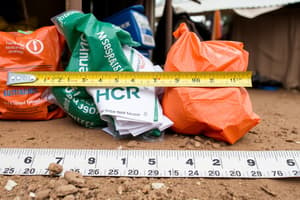Podcast
Questions and Answers
What factor significantly contributes to the working poor in Hong Kong?
What factor significantly contributes to the working poor in Hong Kong?
- Government subsidies for housing
- High wages in manufacturing jobs
- Flexible employment opportunities (correct)
- Universal basic income
How does social frustration relate to inequality in Hong Kong?
How does social frustration relate to inequality in Hong Kong?
- It reduces perceptions of fairness.
- It leads to increased social mobility.
- It decreases public protests.
- It may result in social movements. (correct)
Which form of poverty is characterized by identity and social efficacy?
Which form of poverty is characterized by identity and social efficacy?
- Subjective poverty (correct)
- Relative poverty
- Objective poverty
- Absolute poverty
What is a potential consequence of living in poverty in Hong Kong?
What is a potential consequence of living in poverty in Hong Kong?
What concept relates to perceptions of fairness and social equality?
What concept relates to perceptions of fairness and social equality?
What can exacerbate the lack of opportunities for young people in Hong Kong?
What can exacerbate the lack of opportunities for young people in Hong Kong?
Which factors intersect to influence poverty dynamics in Hong Kong?
Which factors intersect to influence poverty dynamics in Hong Kong?
What role does foreign direct investment (FDI) play in Hong Kong's economic situation?
What role does foreign direct investment (FDI) play in Hong Kong's economic situation?
What characterizes the East Asian welfare model, particularly in Hong Kong?
What characterizes the East Asian welfare model, particularly in Hong Kong?
Which factors complicate poverty alleviation strategies in Hong Kong according to the provided content?
Which factors complicate poverty alleviation strategies in Hong Kong according to the provided content?
What was a significant government action introduced in 1999 regarding social services in Hong Kong?
What was a significant government action introduced in 1999 regarding social services in Hong Kong?
What was the government's stance on poverty in Hong Kong up until 2013?
What was the government's stance on poverty in Hong Kong up until 2013?
What demographic is significantly affected by the Comprehensive Social Security Assistance in Hong Kong?
What demographic is significantly affected by the Comprehensive Social Security Assistance in Hong Kong?
What misconception about welfare does the government promote in relation to societal values?
What misconception about welfare does the government promote in relation to societal values?
Which phrase captures the relationship between the state, market, and family in the East Asian welfare model?
Which phrase captures the relationship between the state, market, and family in the East Asian welfare model?
Which aspect of education is viewed as a potential solution for social mobility among the poor in Hong Kong?
Which aspect of education is viewed as a potential solution for social mobility among the poor in Hong Kong?
What is the poverty line defined by the Commission on Poverty in Hong Kong for relative poverty?
What is the poverty line defined by the Commission on Poverty in Hong Kong for relative poverty?
What was the population poverty rate in Hong Kong pre-intervention in 2019?
What was the population poverty rate in Hong Kong pre-intervention in 2019?
How many poor households were recorded in Hong Kong post-intervention in 2019?
How many poor households were recorded in Hong Kong post-intervention in 2019?
Which ideology primarily influenced Hong Kong's limited state capacity regarding welfare?
Which ideology primarily influenced Hong Kong's limited state capacity regarding welfare?
What effect does the welfare model in Hong Kong rely upon to boost government revenue?
What effect does the welfare model in Hong Kong rely upon to boost government revenue?
Which of the following statements reflects the welfare model ideology in Hong Kong?
Which of the following statements reflects the welfare model ideology in Hong Kong?
Who were considered the informal caregivers in Hong Kong's welfare model?
Who were considered the informal caregivers in Hong Kong's welfare model?
What was a significant feature of the welfare state in Hong Kong since the 1970s?
What was a significant feature of the welfare state in Hong Kong since the 1970s?
Flashcards
Globalization's effect on HK poverty
Globalization's effect on HK poverty
Globalization, leading to foreign direct investment and deindustrialization, has created a global city with a polarized service sector, resulting in a working-poor population with flexible, part-time, or informal employment, potentially unable to afford basic needs.
Working poor in HK
Working poor in HK
Individuals in Hong Kong with low-paying, flexible, and often informal employment, potentially facing difficulties covering their expenses, even for basic necessities like food.
Poverty's Impact on Individuals
Poverty's Impact on Individuals
Poverty in Hong Kong can lead to deprivation, social exclusion, and a lack of social capital. It can also affect individual perceptions of identity and efficacy.
Social Exclusion
Social Exclusion
Signup and view all the flashcards
Social Capital
Social Capital
Signup and view all the flashcards
Subjective Poverty
Subjective Poverty
Signup and view all the flashcards
Social Inequality (HK)
Social Inequality (HK)
Signup and view all the flashcards
Social Fairness
Social Fairness
Signup and view all the flashcards
Poverty Line (HK)
Poverty Line (HK)
Signup and view all the flashcards
Relative Poverty
Relative Poverty
Signup and view all the flashcards
Post-intervention Poverty Rate
Post-intervention Poverty Rate
Signup and view all the flashcards
Pre-intervention Poverty Rate
Pre-intervention Poverty Rate
Signup and view all the flashcards
Hong Kong Welfare Model
Hong Kong Welfare Model
Signup and view all the flashcards
Trickle-down Effect
Trickle-down Effect
Signup and view all the flashcards
Welfare as a Social Right?
Welfare as a Social Right?
Signup and view all the flashcards
Small Government Ideology
Small Government Ideology
Signup and view all the flashcards
Productivist Welfare Capitalism
Productivist Welfare Capitalism
Signup and view all the flashcards
Social Policy Subordination
Social Policy Subordination
Signup and view all the flashcards
Limited Social Stratification
Limited Social Stratification
Signup and view all the flashcards
State-Market-Family Relationship
State-Market-Family Relationship
Signup and view all the flashcards
Lack of Poverty Line (Hong Kong)
Lack of Poverty Line (Hong Kong)
Signup and view all the flashcards
Culture of Poverty
Culture of Poverty
Signup and view all the flashcards
Economic Development Over Other Concerns
Economic Development Over Other Concerns
Signup and view all the flashcards
Working Poor
Working Poor
Signup and view all the flashcards
Study Notes
Inequality: Social and Political Consequences
- Inequality's consequences include poverty and social unrest.
Defining Poverty (Hong Kong, 2019)
- The Commission on Poverty uses a relative poverty measure.
- The poverty line is set at 50% of the median monthly household income before policy interventions (taxation and social welfare transfers).
- Median CSSA income is HKD2,455.
- Poverty lines vary by household size, ranging from 4,500forsinglepeopleto4,500 for single people to 4,500forsinglepeopleto23,000 for 6+ person households. (These figures are from 2019 data).
Poverty Rates (Hong Kong, 2019)
- Post-intervention: 9.2% poverty rate, with 0.287 million poor households out of 0.642 million people.
- Pre-intervention: 21.4% poverty rate, with 0.649 million poor households out of 1.491 million people. (These figures are theoretical pre-intervention estimates.)
Poverty Lines by Household Size (2009-2019)
- Charts show poverty lines changed over time, varying by household size. The amounts increased over the 2009-2019 period.
Welfare Model of Hong Kong (Recap)
- Hong Kong's welfare model historically has been strongly influenced by the colonial past and a need for social stability, which has led to a paradox.
- A strong state role in funding services (e.g., healthcare, education, housing since the 1950s).
- This has been contrasted with a limited state capacity due to a 'small government' ideology.
- Hong Kong's welfare system is residual (more focused on individual and family support).
- It is highly institutionalized but differs from others concerning financial conservatism, low tax rates, and non-interventionism in the economy.
Welfare Model of Hong Kong (Recap) - Continued
- Economic growth is crucial for funding welfare programs (trickle-down effect).
- Emphasis on self-reliance over government support is a key feature.
- Family, rather than the state, often plays a leading role in 'informal care'.
Productivist Welfare Capitalism (lan Holliday)
- Hong Kong's welfare model fits a 'facilitative' subtype, prioritizing economic policy over social policy.
- Social rights are minimal and linked to productive activity.
- Stratification effects in the job market are meant to encourage productivity.
- State-market-family relationship is prioritized toward economic growth.
- Private and public sectors work together.
Post-1997 Poverty Policy Issues
- Excessive focus on promoting economic development and human capital.
- Hope that universal education would empower the poor, but university admission rates were still low.
- Poverty policy frequently neglected the problems of the working poor and social exclusion.
How Welfare Model Impacts Poverty in Hong Kong (Micro Level)
- No official poverty line until 2013.
- The government frequently frames poverty as a cultural (dependency) issue to control expenses.
- The government emphasizes family and individual responsibility as main solutions to poverty.
- Government assistance (Social Security Assistance) doesn't reach all eligible elders. (Only 57% apply for benefits).
Explaining Poverty in HK (Macro Level)
- Globalization, foreign direct investment (FDI) and de-industrialization have led to poverty.
- The polarized service sector, working poverty (including flexible employment, part-time, and informal work) and lack of sufficient income for basic needs, such as food, contributes to the problem.
Possible Impacts of Living in Poverty in Hong Kong
- Poverty leads to deprivation.
- Social exclusion.
- Lack of social capital, subjective poverty (identity and efficacy), intersection of poverty and other factors like gender, ethnicity, and age.
Political Consequences of Social Inequality
- What are the ramifications of social inequality in terms of social mobilization, social movements, and social unrest? (Are they short-term or long-term?
S.D. - Inequality → Strain/Frustration → Social Movement Displacement?
- Social frustration is a key factor. Perceptions of fairness (both social and individual) are linked to a desire for upward social mobility, among other factors.
- Unequal conditions are potentially related to youth frustration (higher rates exist in HK and Taiwan than in Macao).
- People with high frustration and unfairness views are more motivated to engage in political action.
H.D. 1 - Inequality Matters (HK-Taiwan Comparisons)
- Taiwan and Hong Kong inequality levels measured through Gini coefficients.
- Perceived income inequality in Taiwan is higher than in Hong Kong.
- Trend in income inequality is an influencing factor more frequently than the actual increase in inequality.
H.D. 2 - Social Movements and Political Opportunity Structure
- Social movements are embedded in existing institutional environments.
- Their growth is partly constrained or facilitated by political opportunity structures.
- Social movements interact with and can reshape the political environment.
Changes in Political Opportunity Structure (1970s-2009)
- 1970s - 1997: increasing accessible political environment for social movements.
- 1997-2009: decrease in accessible avenues for social movements. This was because there was not much change in governance.
Conclusion: Social Inequality and Social/Political Movements
- The conclusion points to a relationship between social inequality and social/political movements.
Changing Political Opportunity + Social Inequality (Summary Table)
- Summarizes the changing political opportunities and correlates with social inequality in Hong Kong.
Studying That Suits You
Use AI to generate personalized quizzes and flashcards to suit your learning preferences.




